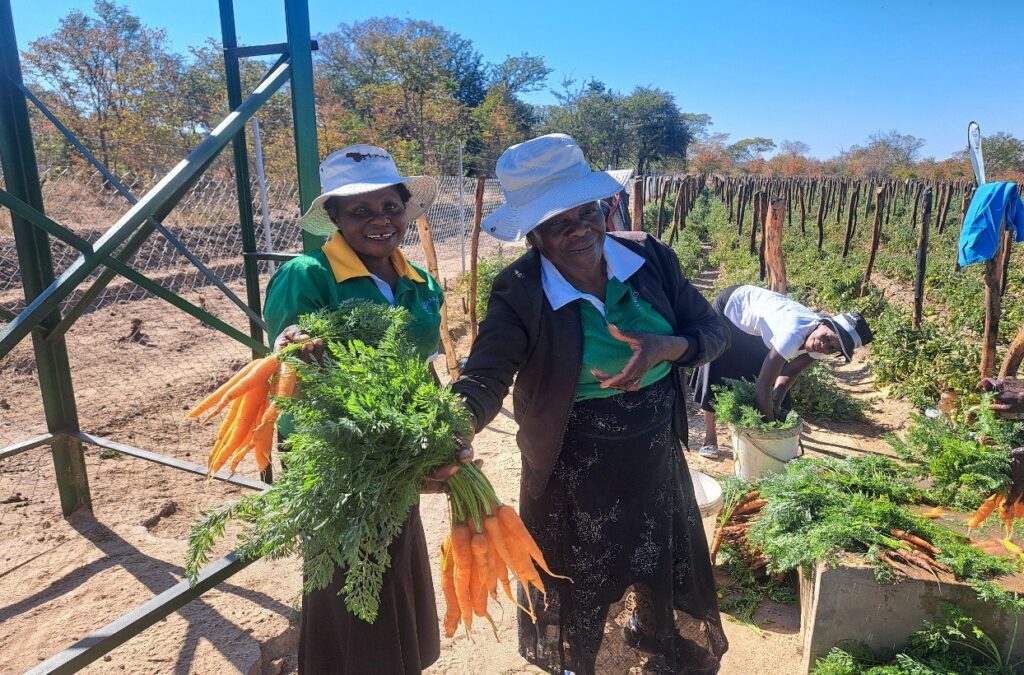
Women prepare carrots harvested from the nutrition corner at Jabatshaba
VBU
By Precious Nkomo
As we drove westwards from the coal mining town of Hwange towards Victoria Falls, we could not ignore the searing heat, the dry air, the Mopane and acacia trees, stripped bare of their leaves and the bare ground with brittle brown grasses. A hundred kilometres from Hwange, we turned right and travelled for a further sixty kilometres northwards, towards the Zambezi escarpment wherein Jambezi communal lands lies.
Jambezi was bone dry, lying in agro-ecological region 5 receiving an average of rainfall of 450mm with temperatures soaring to highs of between 24 degrees to 33 degrees celcius. The little, intermittent rains often start in the months of October and last up to April. Cattle and people in many villages competed for water, usually, from one water source.
At the edge of Jabula Village, next to a small hill, our attention was drawn to two green water tanks perched on steel structures. Next to the hill, lay a new sight in the arid Hwange community, a 1.25 hectare garden with flourishing different crops that included cabbages, carrots, tomatoes, spinach, and green vegetables. Two women, one middle aged who identified herself as Lillian Sibanda and youthful Talent Moyo were harvesting tomatoes that would be picked up by an off-taker based in the nearby resort town of Victoria Falls.
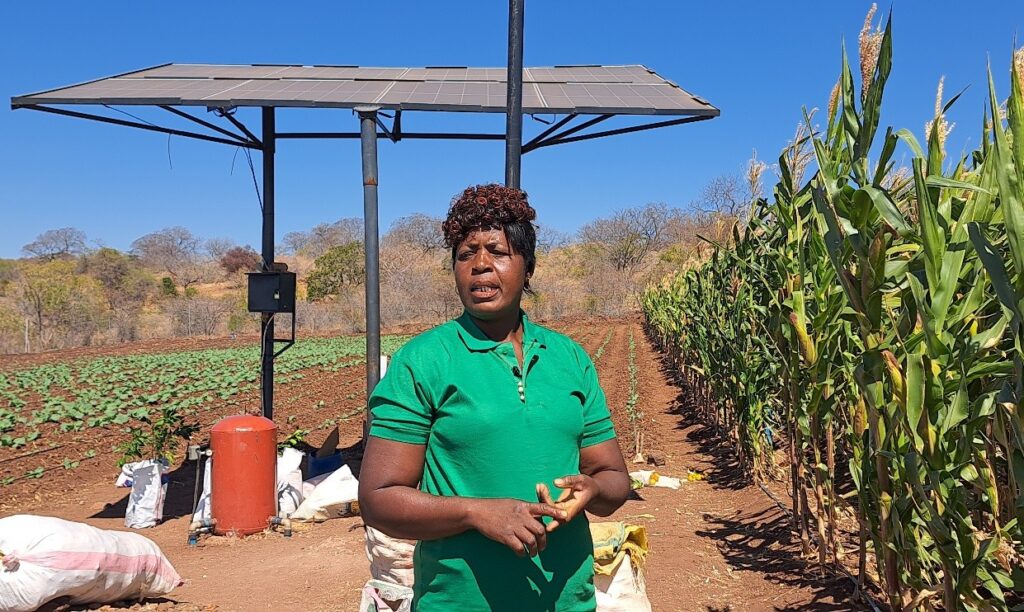
Above- Lilian Sibanda of Jabula Village Business Unit
This is Kasikili Jabula Village Business Unit, in Hwange district of Matabeleland North Province, established in 2024 by the Smallholder Agriculture Cluster Project, co-financed by the Zimbabwean Government in partnership with the International Fund for Agricultural Development (IFAD) and the OPEC Fund for International Development (OFID). As part of its infrastructural intervention to build climate resilience among smallholder farmers, the project is establishing 100 multi-purpose water points, spread across Matabeleland North, Midlands, Mashonaland West, Mashonaland East and Mashonaland Central.
Forty village business units were set up in Matabeleland North Province, the hardest hit by the El Nino induced drought among the provinces covered by the project during the 2023-2024 rainy season. The Zimbabwe Livelihoods Assessment (ZIMLAC, 2024) reported that most districts in the province suffered a prolonged dry spell affecting 97% of the households in districts such as Lupane and Nkayi. Communities also lost livestock as a result of shortages of both pastures ad water for livestock and this affected 25 % of households in Binga and a further 22% in Lupane.
The multi-purpose water points, commonly called village business units are similar to those established by Government under its Rural Development 8.0 intervention and have presented multiple benefits for farmers in arid areas. The intervention included fencing off a 1.25 hectare garden, with 1 hectare being used for commercial use and 0.25 hectares is for nutrition purposes. The project installed two 10 000 water tanks, multiple water taps for domestic water use, a drinking trough for livestock With the solar power that is part of the infrastructure intervention, the multi taps for fetching water and drinking troughs for their livestock, they provide multiple relief for villagers like Lillian Sibanda and Talent Moyo of Kasikili Jabula Village Business Unit. The VBU has 30 beneficiaries who grow different crops in the garden, which include green mealies, cabbage, carrots, spinach, garlic, onions, tomatoes, okra and kale.
Increased production and productivity
As we moved around the garden, Albert Moyo, the committee secretary for the garden explained, “Before SACP we had a small nutrition garden, which measured 70 metres by 70 metres where we used to grow vegetables for consumption. It was, however, not sustainable because we could only irrigate the garden using buckets and the land was small. After the coming in of SACP, we cleared the land and we grew our first crop, which was cabbage and green mealies.
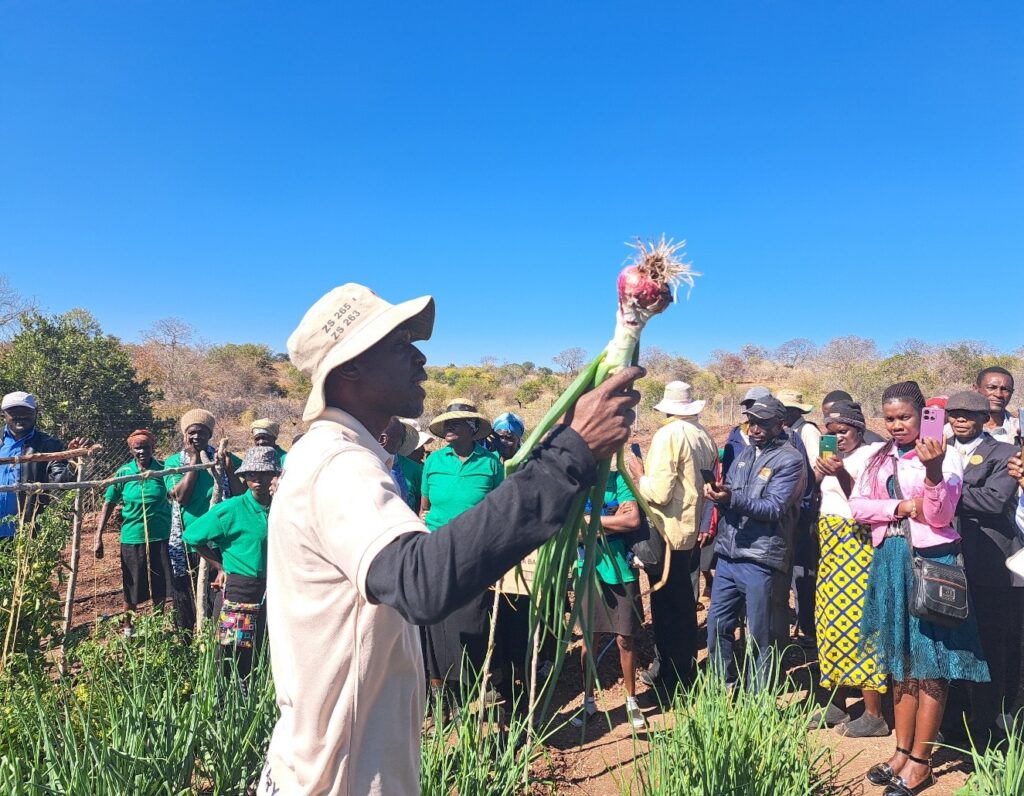
Albert Moyo displays onions from the Jabula VBU
The farmers at Jabula adopted a market-led approach where they engaged an off-taker before growing any crop. Moyo explained, “Each crop that you see here is a response to the demands of the market in the nearby resort town of Victoria Falls. The off taker for the VBU comes here every week to pick up vegetables for sale in Victoria Falls. We are assured of a reliable, steady income and we are sure that we will not suffer any losses emanating from the lack of markets. Right now we are in our second crop cycle.”
Improved nutrition
The rural community, which faced perennial challenges of inadequate food has reported being food secure, following the establishment of the garden. Moyo added that, “We also established a nutrition corner where we cultivate kale, onions and tomatoes which have done extremely well We are food secure at homestead level and also able to supply vegetables to nearby schools to support the schools feeding programme, complimenting Government’s efforts as it is supplying grain used to prepare the staple food, isitshwala. The vegetables from this garden provide relish for our children during these feeding programmes.”
Mrs Lillian Sibanda, another member of the Jabula VBU adds that, “We planted okra, spinach, covo, carrots, and garlic, with a dedicated nutrition corner for family consumption. This garden serves as a source of relish for us and our neighbours who are not members of the garden.”
In Jabatshaba, Lucy Moyo the VBU chairperson said, “While we sold the bulk of our crop from the commercial plot, we also harvested and shared 120 cabbages which were shared among the 30 households for consumption. We also utilised 120 buckets of tomatoes for domestic consumption and these were shared among the 30 beneficiary households. In addition to the crops in the commercial plot, we have cultivated carrots and leafy green vegetables which are shared among households. From the nutrition corner, we have also realized a surplus which we are selling to nearby boarding schools, Mabhikwa High School and Fatima High School.”
More money in the pocket
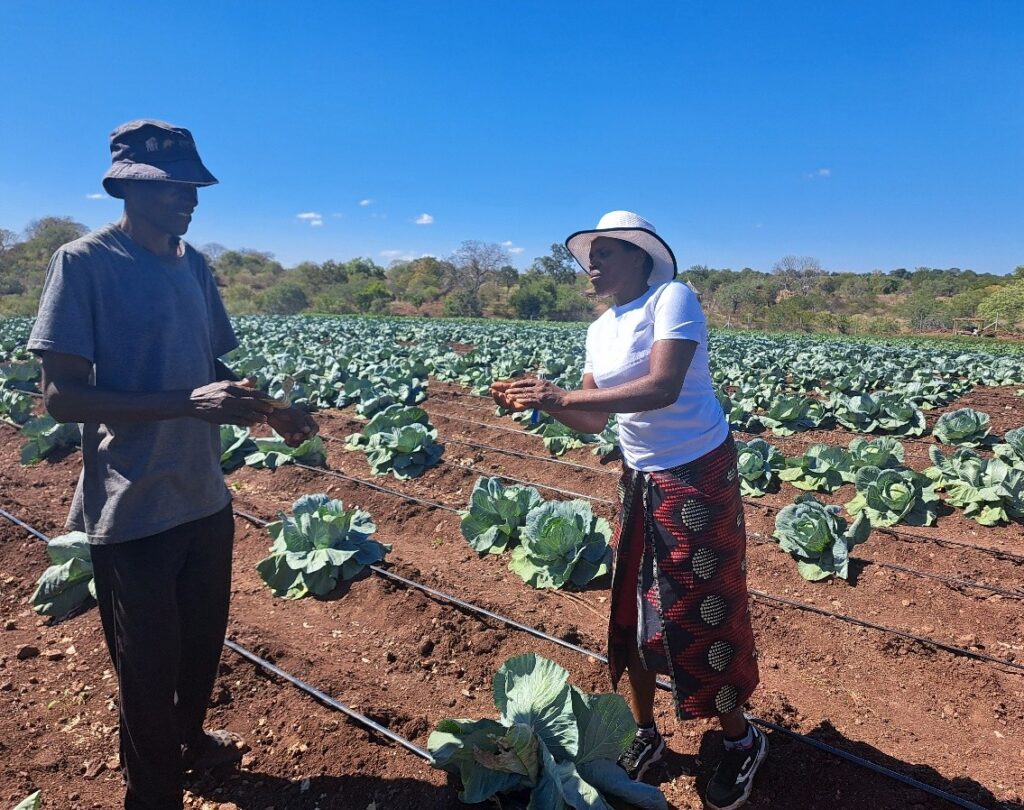
A customer buys vegetables from the Jabula VBU
One of the benefits from the multi-purpose water point has been the improved incomes for the farmers. Lillian Sibanda of Kasikili Jabula said, “We are now generating income from the sale of the garden produce, which we are using to pay school fees. For us, the VBU has generated US$4 122 from its first crop cycle. We grew cabbage on 0.35 hectares and harvested 10620 heads which the farmers sold for $$2,134.The tomato crop from 0.05 hectares yielded 1000 kilograms which we sold for US$414.00.
From our maize crop which we grew on 0.55 hectares, we harvested 3,300 kilograms which we sold for $1,400. We also sold okra, carrots, covo, spinach and chomoullier where we got an income of US$174”.
It is the same at Jabatshaba VBU in Lupane, where the Chairlady Lucy Moyo, said, “The beneficiaries have started realizing an income from the village business unit. After planting the first cycle of crops which included cabbages, tomatoes as well as carrots and rape which formed the nutrition corner, the farmers realized US$6 431.00.
The farmers harvested 636 buckets of tomatoes which they sold for prices ranging from US$4 to US$7 depending on the tomato sizes and quality and made a total income of US$3 672.00.Out of the 3 332 heads of cabbage, making and income of US$2559.”
The garden already has a plan for maintenance which constitutes 10% of their income. This will be used for any repairs to both the water point and the garden.
Reduced livestock losses
Jabula, which is close to both Hwange National Park has been experiencing livestock losses to wild life attacks. Among the numerous benefits to the Jabula community is the ease of watering their livestock. The addition of the drinking trough and the solarisation of the borehole has enabled the community to water their livestock closer to their homesteads. Lillian Sibanda notes that, “The solarization of this borehole by SACP has reduced the distance livestock travelled to Zambezi River for water and minimized instances of stock theft by cross border cattle rustlers. I would like to thank SACP for this project.”
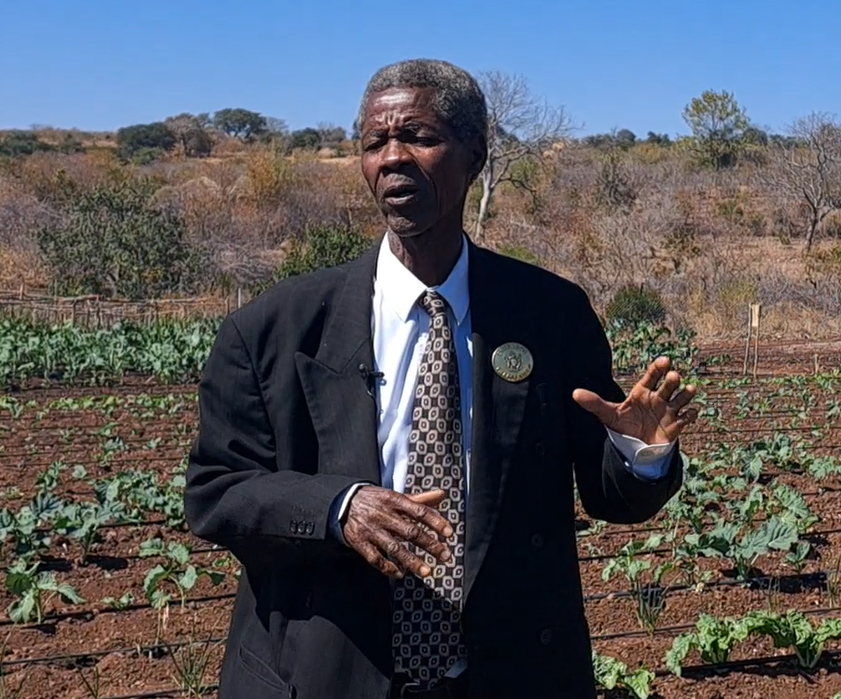
Traditional leader, Christopher Sibanda (above) reiterates, “It’s now easier to water our cattle. They used to walk about 5km to the nearest water point or sometimes even more. Some of the cattle would go missing after being eaten by wild animals. Because of SACP, we now water our cattle in the drinking trough that is part of this VBU.”
Better access to water, less time spent queueing for water
In dry areas lying in the Agro-ecological region 5 like Hwange and Lupane, communities rely on boreholes for drinking water. However, most of the boreholes are bush pumps which are often difficult to operate.
At Jabatshaba, Lucy Moyo said, “Before this intervention, it was very hard to operate this borehole. It had 16 pipes and was very heavy. Women were forced to pump as groups as one person was not able to operate the borehole.Now, we just open the taps and fetch water, there are less conflicts over water and watering livestock. Community members used to spend a lot of time at the water point, and there were endless arguments over who came to the borehole first. This water point has made it easier for all community members including the elderly and PWDs to easily access water.”
Inclusive technology
The borehole has also ensured ease of use for vulnerable members of the community such as the elderly and Persons with Disabilities.
Thembelani Ndlovu, the Vice Chairperson of the Jabatshaba VBU who also has a disability added,“For some of us who have disability, this intervention has made a positive difference. We no longer pump water from the borehole but we fetch water from the taps. This is less strenuous for us and the elderly. This SACP intervention has enabled us to water the livestock as PWDs since the technology is no longer laborious.”
